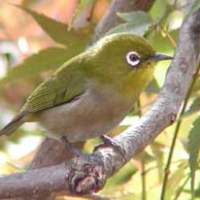* Japanese name: Mejiro
* Scientific name: Zosterops japonicus
* Description: The white-eye is a small, delicate bird, with an olive-green upper body, wings and head, and a gray to pale-brown belly. The distinguishing feature is the bright-white eye ring made of feathers (the Japanese name means "white eye"). It is only about 11 cm long and weighs around 10 grams. It has a fine, sharp bill and a brush-tipped tongue. The white-eye is also known for its beautifully melodic song, especially in the mornings.
* Where to find them: In trees. The white-eye is a common bird, found all over Japan, including Okinawa. It lives in forests and woods, gardens and parks and even in mangroves in the south. The white-eye is seldom to be seen on the ground -- it prefers to be in trees. It also seems to enjoy the company of other white-eyes: from July to February these birds commonly form flocks numbering more than 200. White-eyes sleep with the head tucked under the wing, often perched on one leg.
* Food: White-eyes are omnivorous, foraging in vegetation at all levels from the canopy to the tree trunk and in dense leaves. They pick off insects when they find them under leaves, and insect larvae by probing in bark. White-eyes also eat fruit and sap from trees and flowers. They play an important part in dispersing the seeds of berries they eat and have recently been identified as the main pollinators of camellias. No other temperate-living bird is known to play so important a role in flower pollination as the white-eye.
* Special features: White-eyes often groom each other. Although preening the feathers for mites and ticks might supplement the diet, the main reason is to form bonds during flocking, and most importantly, during courtship. Pairs are loyal and remain together for several years, raising up to three broods of two to five chicks per year. Mates build a nest (in a tree, naturally, 1-30 meters above ground), using moss, spiders' webs, lichens and mammalian fur. The pairs are strongly territorial and use several displays to other birds to communicate their status. These include aggressive wing-fluttering, wing flicks and beak snaps. The males sing loudly to establish and maintain the territory. Some territories are small (1,200 sq. meters), others rather large (3 sq. km), which might account for the effort the male puts into singing.
1 hour ago



















With your current subscription plan you can comment on stories. However, before writing your first comment, please create a display name in the Profile section of your subscriber account page.